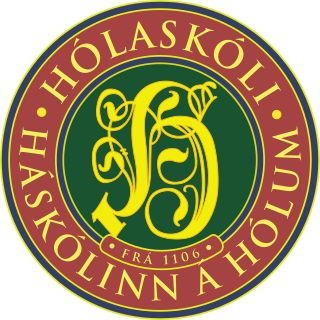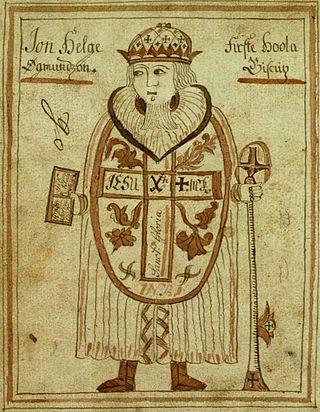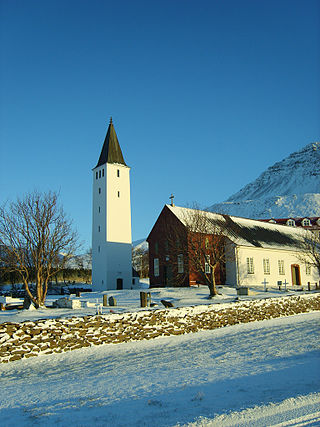Gallery
- reliquary of Guðmundur Arason
- Statute of Guðmundur Arason.
- Manuscript showing Arason.
- Olav der Heilige
- Olav
- Jón Ögmundsson of Holár
The following is a list of saints of Iceland. The list includes all Christian saints with Icelandic connections, either because they were of Icelandic origin and ethnicity, or because they travelled to Iceland from their own homeland and became noted in their hagiography for their work in Iceland and amongst the Icelandic people. A small number may have had no Icelandic connection in their lifetime, but have nonetheless become associated with Iceland through the depositing of their relics in Icelandic religious houses in the Middle Ages.
Thorlak Thorhallsson (Icelandic: Þorlákur Þórhallsson) is the only canonized saint native to Iceland, and since 1984 has functioned formally as the country's patron saint despite centuries of devotion.
By the time of his birth, the Catholic Church was firmly established in Iceland following contention between Norwegian and German missionaries with native pagan religions in the two centuries preceding.
Thorlak was born into an aristocratic family in Hlíðarendi in 1133, Thorlak's parents noticed his budding intellectual capabilities and asked a local priest to instruct him. He was ordained a priest at age 18, and subsequently studied in Paris and perhaps England. After returning to Iceland in 1165, he founded a monastery of Canons Regular and devoted himself to a life of contemplative prayer.
He was ordained a bishop by Augustine of Nidaros in 1178 and worked to reform the Church and religious life in Iceland. He died on December 23, 1193, and his relics were translated to the cathedral of Skálholt in 1198.
His informal veneration in Iceland began less than a decade following his death with the translation of his earthly remains. Pope John Paul II canonized him in 1984, instituting his feast of December 23 on the liturgical calendar and designating him as patron saint of Iceland. [1] The same pontiff visited Iceland five years following, at which occasion the Icelandic saga Þorláks saga helga (the Saga of Saint Thorlak) was republished in commemoration of the papal visit.
| Name | Lived | Feast Day | Notes |
|---|---|---|---|
| Brendan | 5th Century | 16 May | May have visited Iceland. [2] [3] |
| Nicholas, patron of seafarers | 4th Century | 6 December | Venerated by Icelandic Fishermen. |
| Olaf II | 11th century | 29 July | Popular foreign saint [4] [5] |
Many places like Iceland and Wales [6] that were distant from Rome and in relative isolation were overlooked when it came to placing saints in the Catholic calendar. This explains why Iceland has only one saint recognised by the Vatican. [7] The only canonised saint was elevated in 1984 by Pope John Paul II.
Nonetheless, and also like many isolated areas, Iceland has a handful of local persons historically venerated as saintly. Among these are Jón Ögmundsson and Guðmundur Arason, the first and fifth Bishops of Hólar respectively.

In religious belief, a saint is a person who is recognized as having an exceptional degree of holiness, likeness, or closeness to God. However, the use of the term saint depends on the context and denomination. In Catholic, Eastern Orthodox, Anglican, Oriental Orthodox, and Lutheran doctrine, all of their faithful deceased in Heaven are considered to be saints, but some are considered worthy of greater honor or emulation. Official ecclesiastical recognition, and consequently a public cult of veneration, is conferred on some denominational saints through the process of canonization in the Catholic Church or glorification in the Eastern Orthodox Church after their approval.

Olaf II Haraldsson, later known as Saint Olaf, was King of Norway from 1015 to 1028. Son of Harald Grenske, a petty king in Vestfold, Norway, he was posthumously given the title Rex Perpetuus Norvegiae and canonised at Nidaros (Trondheim) by Bishop Grimkell, one year after his death in the Battle of Stiklestad on 29 July 1030. His remains were enshrined in Nidaros Cathedral, built over his burial site. His sainthood encouraged the widespread adoption of Christianity by Scandinavia's Vikings/Norsemen.

The Church of Iceland (Þjóðkirkjan), officially the Evangelical Lutheran Church of Iceland, is the national church of Iceland. The church is Christian and professes the Lutheran faith. It is a member of the Lutheran World Federation, the Porvoo Communion, the Communion of Protestant Churches in Europe, and the World Council of Churches.

Blaise of Sebaste was a physician and bishop of Sebastea in historical Armenia who is venerated as a Christian saint and martyr.

Hólar is a small community in the Skagafjörður district of northern Iceland.

Hólar University is located in Hólar, Iceland, an important historical centre of education. The university, which was the first post-secondary school in Hólar, was founded in 1106. It was renamed Hólar Agricultural College in 1882 and became Hólar University in 2007. Established in the 12th century, Hólar is one of the oldest universities in Europe.

Jón Ögmundsson or Ogmundarson, also known as John of Holar and Jon Helgi Ogmundarson, was an Icelandic bishop and local Icelandic saint. In 1106, the second Icelandic diocese, Hólar, was created in the north of Iceland, and Jón was appointed its first bishop. He served as bishop there until his death.

The Catholic Church in Iceland is part of the Catholic Church, under the spiritual leadership of the Pope. The island is served by a single diocese, the Diocese of Reykjavík, having a total of seven parishes. As of 2015, the ordinary is bishop Dávid Bartimej Tencer. The diocese is directly subject to the Holy See.
Guðmundur Arason was an influential 12th and 13th century Icelandic saintly bishop who took part in increasing the powers of the Catholic Church in medieval Iceland. His story is recorded in several manuscripts, most notably Prestssaga Guðmundar góða. He is often referred to as Guðmundur góði.
Thorlak Thorhallsson is the patron saint of Iceland. He was bishop of Skálholt from 1178 until his death. Thorlak's relics were translated to the cathedral of Skalholt in 1198, not long after his successor as bishop, Páll Jónsson, announced at the Althing that vows could be made to Thorlak. His status as a saint did not receive official recognition from the Catholic Church until 14 January 1984, when John Paul II canonized him and declared him the patron saint of Iceland. His feast day is 23 December, when Thorlac's mass is celebrated in Iceland.
Guðmundar saga biskups or Guðmundar saga Arasonar is an Icelandic bishops' saga, existing in several different versions, recounting the life of Bishop Guðmundur Arason (1161–1237). Since the saga survives in different versions, it is common to speak of it in the plural, as Guðmundar sögur.
Auðunn rauði Þorbergsson was bishop of Iceland's northern diocese of Hólar 1313–22.
Ormr Ásláksson was Bishop of Hólar, Iceland's northern diocese, from 1343-56.

The history of Christianity in Iceland can be traced back to the Early Middle Ages when Irish hermits settled in Iceland at least a century before the arrival of the first Norse settlers in the 870s. Christianity started to spread among the Icelanders at the end of the 10th century. The adoption of the new faith by the whole population was the consequence of a compromise between the Christian and heathen chieftains, as well as the lawspeaker, at the national assembly or Alþingi of 999 or 1000.
The bishops' saga is a genre of medieval Icelandic sagas, mostly thirteenth- and earlier fourteenth-century prose histories dealing with bishops of Iceland's two medieval dioceses of Skálholt and Hólar.
Þorláks saga helga is a saga about Saint Þorlákr Þórhallsson (1133–93) and the main source of evidence for his life.
Saints' sagas are a genre of Old Norse sagas comprising the prose hagiography of medieval western Scandinavia.

Hólar Cathedral is a Church of Iceland cathedral church located in Hólar, Iceland. The church is the official church of the Bishop of Hólar, currently Solveig Lára Guðmundsdóttir.